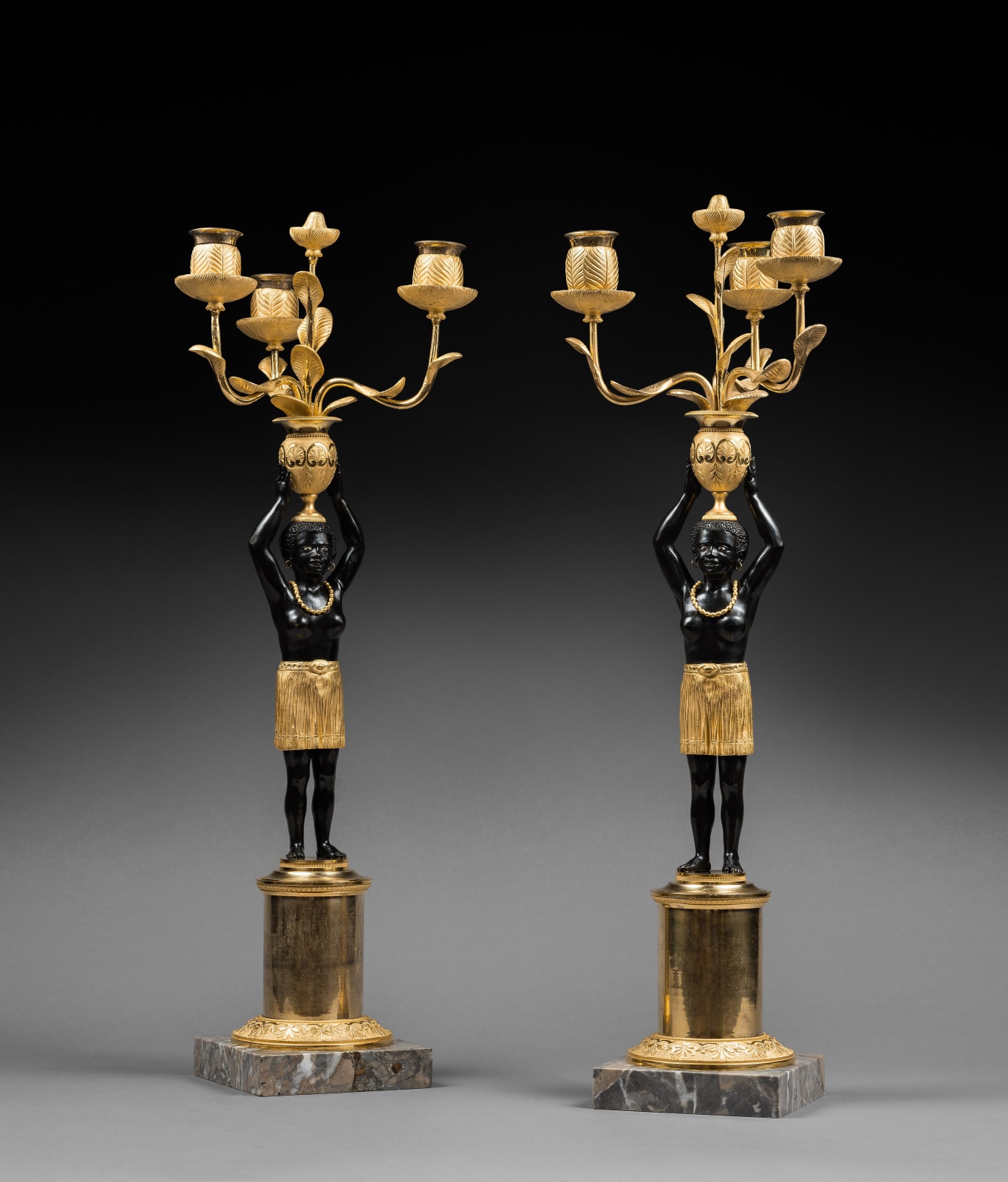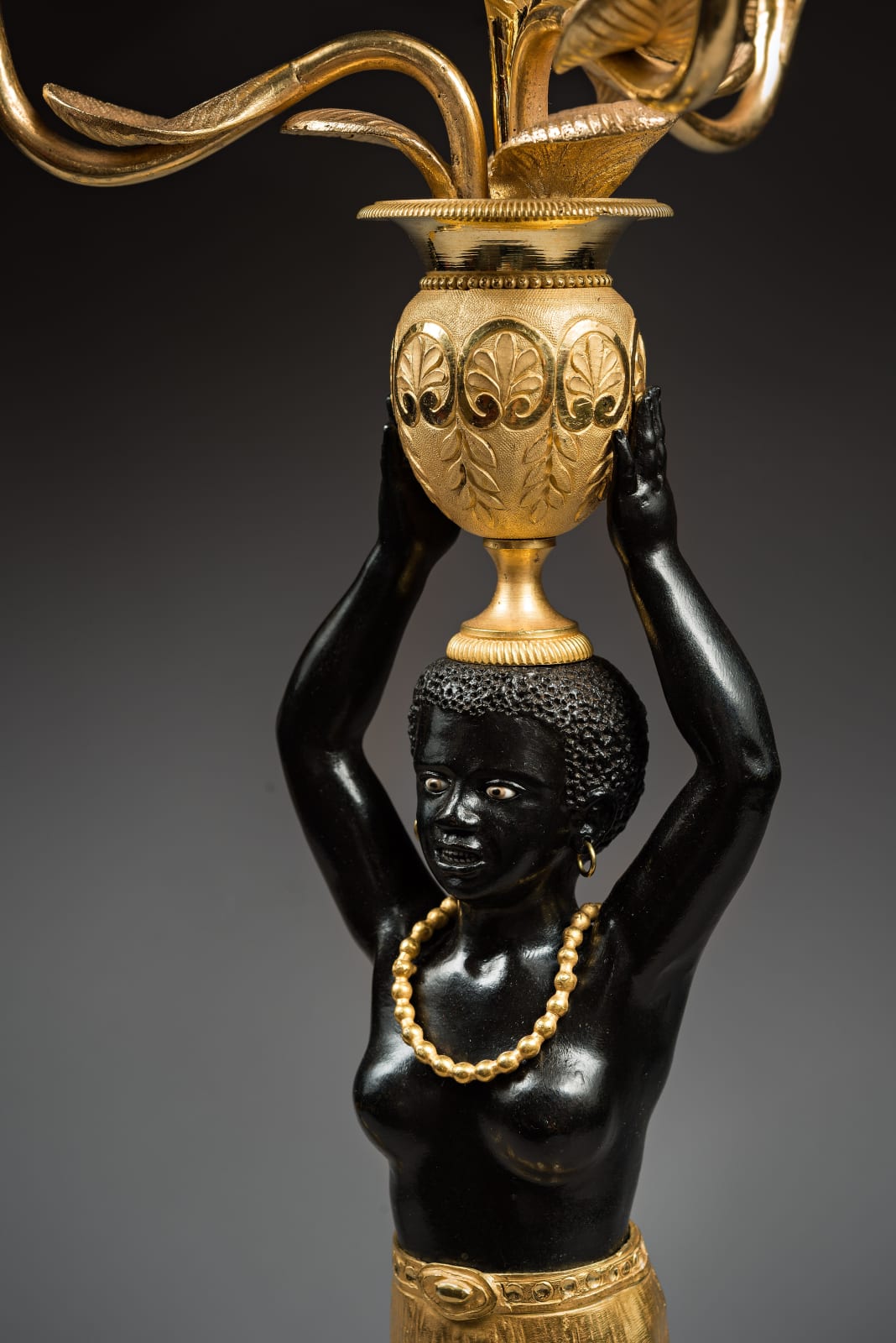Jean-Simon Deverberie (attributed to) 1864-1824
Literature
Elke Niehüser, “Die Französische Bronzeuhr”, 1997, back cover illustrating a Deverberie pendule à l’Amèrique flanked by an identical pair of candelabra, and p. 161, pl. 262, showing a similar pair of candelabra by Jean-Simon Deverberie each formed as a young African boy holding in either hand a single candle branch and accompanying a central Deverberie pendule au Nègre in the Musée François-Duesberg at Mons in Belgium.
A very fine pair of Directoire gilt and patinated bronze three-light candelabra ‘Au Jeune Nègre’ attributed to Jean-Simon Deverberie, each with a patinated bronze figure of a young African girl with white enamel eyes wearing a beaded necklace and a tassel-hung loincloth, her hands held aloft to support on her head a vase cast with stiff leaves issuing three scrolled candle branches and a central upright branch each adorned with banana or other exotic leaves, the central branch terminated by an exotic seed pod finial and the three candle branches by a vase-shaped nozzle cast with banana or other exotic leaves above a similarly cast drip-pan, each figure standing on a circular base cast with an anthemion border on a square marble base
Paris, date circa 1800
Height 54 cm. each.
This striking pair of candelabra, each formed as a young female caryatid African, reflects the enduring fascination with exotic ornament in French art and architecture. Interest in the exotic during the late eighteenth century permeated French society more subtly through the Enlightenment concepts of le bon sauvage or noble savage and man’s gentle original nature as expressed by the philosopher Jean-Jacques Rousseau (1712-1778) and others. These ideas influenced writers such as Bernardin de Saint-Pierre, whose 1787 novel Paul et Virginie described a harmonious life between all races on the French island of Mauritius. Novels such as this as well as earlier accounts of real discoveries by men such as James Cook and Louis Antoine Bougainville together with the arrival in Europe in 1769 and 1775 of two natives from the South Seas – Aotourous and Omai, inspired a new wave within the fine and decorative arts illustrating the notion of le bon sauvage.
Among them were a number of innovative clock cases by the Parisian bronzier Jean Simon Deverberie (1764-1824). His set of designs from 1798-99, now housed in thein the Cabinet des Estampes, Bibliothèque Nationale Paris, included a series of pendules au Nègre such as those for his most famous examples which feature personifications of the continents Africa and America. In particular, one such pendule d’Amèrique garniture is illustrated on the back cover of Elke Niehüser’s, “Die Französische Bronzeuhr”, 1997, which is accompanied by pendant candelabra that, except for additional mounts on the plinths, are identical to the present examples. Other variations of these candelabra are known including some with distinctive elephant headdresses while the more common Deverberie candelabra au sauvage are those featuring young African boys which can be seen as garnitures to Deverberie’s pendules d’Afrique and Amèrique in the Musée de François-Duesberg at Mons in Belgium.
Whilst Deverberie specialised in the production of clock cases and was, with Jean-André Reiche (1752-1817), the most famous maker of pendules au sauvage, he also produced an array of other luxury bronzes from candelabra and chandeliers to chenets and fire grates. Although the exact date when he became a maître bronzier is unknown, we know that he was working as a caster in 1788 and that he married Marie Louise Verron but had no children. An article by Charlotte Vignon from Cleveland Museum of Art notes that he may have been the same Deverberie who specialised as a watchcase maker and that after the abolition of the guilds in 1791, he opened a bronze casting and clock factory with Jean George Hertzog. Having been established at rue Barbet in Paris, Deverberie then moved to rue des Fossés du Temple where he ran the firm of Deverberie et Cie. The lifting of the guild regulations during the French Revolution allowed casters, who during the ancient règime were strictly limited to working in bronze, to now develop their own factories. Deverberie was one such man who took advantage of this freedom so that now all stages of the bronze making process, from casting, gilding, assembly and retail could occur in one workshop. In this he proved so successful that by 1803 his business was worth 104,000 francs. In contrast to a number of other major bronziers, Deverberie did not directly supply the Garde-Meuble though he may have done so through as intermediary. Rather he tended to supply private clientele and also sold his clocks and presumably other bronzes elsewhere in France as well as Germany, Moscow and for the Turkish export market.



